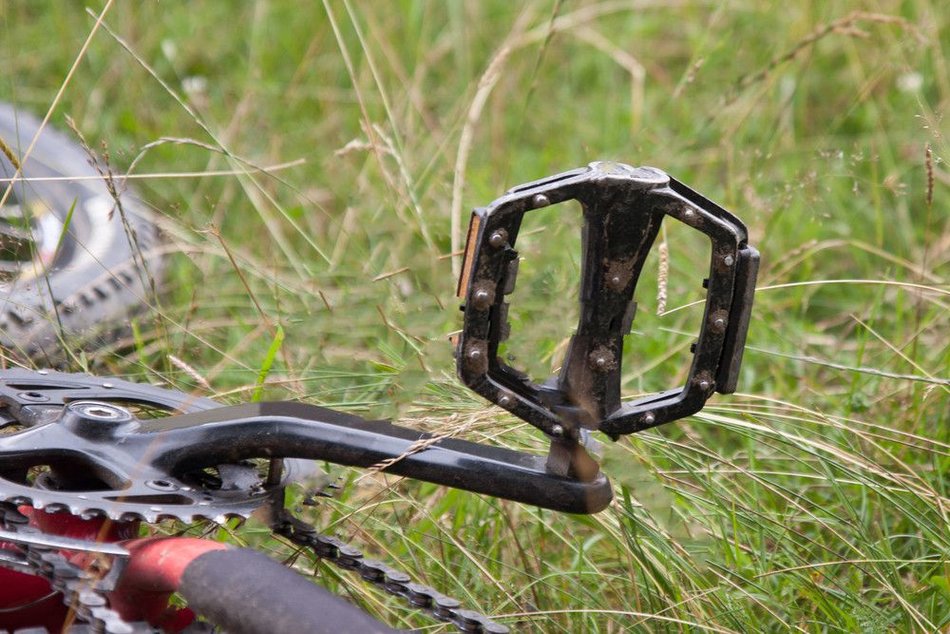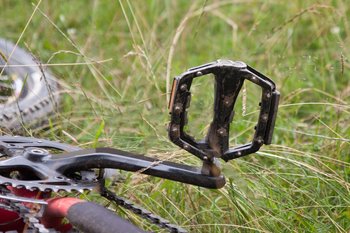
Yes, pedals are universal for mountain bikes. But this depends on the type of crankset you have. A 1-piece crankset uses 1/2′ inch in diameter pedals. Two piece and three piece cranksets use a 9/16′ inch in diameter pedals.
What is a Crankset
A crankset is basically what you use to pedal your mountain bike so you can go forward. The crankset consists of the left crank arm, the right crank arm, and the spindle. The left crank arm attaches to the left pedal and the right crank arm attaches to the right pedal.
The spindle is the axle which goes through the bottom bracket. On one end of the spindle the left crank arm is attached and on the other end the right crank arm is attached. Also attached on the right side is the chainring.
How To Tell If Your Pedals Are 1/2 or 9/16 Inches
The easiest way to know whether you have 1/2 or 9/16 pedals would be to take apart the crankset on your mountain bike.
If after you take it apart and the left crank arm is still part of one end of the axle, and the right crank arm is still part of the other end of the axle all as 1 piece, then you have a 1 piece crankset. Remember it should all be 1 piece, you should not be able to detache any piece.
Any pedal which is 1/2′ inches in diameter will universally fit into any 1 piece crankset.
If after you take apart your bike’s crankset and you are left with an axle and crank arm as 1 piece and another crank arm which is detachable, then you have a 2 piece crankset.
If after you take apart the crankset and you are able to detach both left and right crank arms, then you have a 3 piece crankset. Left and right crank arms and the axle.
Any pedal which is 9/16′ inches in diameter will fit into any two or three piece crankset.
Which is Better a 1 Piece Crankset or a 3 Piece Crankset
We know mountain bike pedals are universal based on what type of crankset you have. Now we need to know which crankset is best to have on our bike. Overall a 3 piece crankset has the most advantages when compared to a 1 piece crankset. Here they are…
- Stronger. A three piece crankset is stronger than a 1 piece because it is made with better material such as aluminum, titanium, and carbon. This is especially important when you are riding downhill, doing jumps, going off drop offs, and doing tricks.
- Smoother ride. A 3 piece has sealed bearings which gives you a more stable and smooth ride. These bearings reduce friction and handle the stress and impact of mountain biking.
- Warranty. A 3 piece crankset has a limited lifetime warranty, so as long as you don’t void the warranty if the crankset breaks you can get it replaced. You are not going to find any type of warranty for a 1 piece crankset.
- Less expensive. Even though at first a 3 piece crankset is more expensive than a 1 piece in the long run it will cost you less money. You will need to replace your 1 piece more often than the 3 piece. Plus even if you need to replace the 3 piece chances are you only need to replace 1 of the 3 pieces which is less money.
- No bending. Because the 3 piece is made from 3 individual pieces there is a lot less chance that any of the parts will bend. The riders weight is distributed more evenly on a 3 piece. Because a 1 piece is only 1 piece all the weight is pushing down on the pedals. This willl cause the 1 piece bar to bend on either side of the crankset.
- Top of the line. Three piece cranksets are the most advanced at this time. While a one piece is usually found on older bicycles and children’s bikes. The most advanced 3 piece is made with 100% heat treated tubular chromoly crank arms which are very strong.
Are All Mountain Bike Pedals the Same Thread Size
This answer is very simple, Yes. The TPI or threads per inch is 20 for both the 9/16′ inch diameter pedals and the 1/2′ inch diameter pedals. This is the same for all cranksets no matter how many pieces.
One caveat is that older bikes may have a different thread shape even though the number of threads is the same. You may just need to use a wrench to get it on or you may need to tap it in with a hammer. With newer bicycles there should be no problem. There is also no problem when it comes to if you can use mountain bike pedals on a road bike.
Can You Change Your Pedal From a 1/2′ to a 9/16′ Pedal
Yes you can. You can change from a 1/2′ to a 9/16 pedal and you can change from a 9/16 to a 1/2 pedal. You can do this by using a pedal axle adapter.
If you want to change from a 1/2′ to a 9/16′, get a pedal axle adapter. The adapter will have a 1/2′ thread which will fit into your 1 piece crank and the other end has a 9/16′ screw where you can attache the 9/16′ pedal you want. You can do the same thing going from 9/16 to 1/2.
Are Mountain Bike Pedals Reverse Thread
Yes and no. All mountain bike pedals which are on the left crank or non-driver side are reverse thread. So to take the pedal off turn it clockwise. All bike pedals on the right crank have a standard thread meaning to take off the pedal turn it counter clockwise.
If you want to put the left pedal on the left crank arm turn it counter clock wise. If you want to put the right pedal on the right crank arm turn it clockwise.
Why is the Left Pedal Reverse Thread
The left pedal is reverse thread so that it will not unscrew itself off while you are pedaling. If the left pedal were standard thread and you were pedaling forward the spindle would rotate in the opposite direction in the crank arm. This would cause the pedal to eventually loosen and come off.
So by reversing the thread of the left pedal when you pedal forward you are effectively tightening the left pedal to the left crank arm. For the right pedal no reverse thread is needed, because the spindle tightens the right pedal with normal pedaling because the pedal spins counter clockwise relative to the spindle.
What Tools Do You Need To Remove and Install Pedals
You are going to need a 9/16′ pedal wrench. This wrench will have a 9/16′ inch precision opening and another opening which is 15mm. You can use either opening in order to remove and install a 9/16 pedal.
For a 1/2′ inch pedal it is a good idea to get an adjustable wrench. Just put the wrench around the nut and turn the knurl in order to tighten the jaws around the nut.

